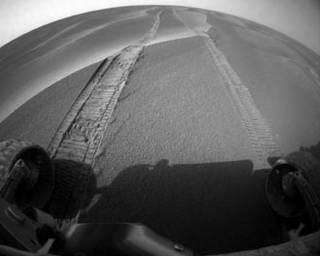Evaluating Arm Positions Offer Many Opportunities On Marsby Staff Writers

This week the Opportunity Instrument Arm Anomaly Team continued investigating the safety of different arm positions. The intent is to determine the safest position to leave the arm while the vehicle drives to new locations.
The original position for the arm while driving was to tuck it underneath the rover, hooked on a small pin. This leaves the partially failed shoulder azimuth joint at 90 degrees to the direction of travel. If the arm stuck in this position we would be unable to use the arm.
The current plan is to investigate different versions of driving with the instrument arm's "elbow" sticking out towards the front of the vehicle, with the arm's instrument cluster above the solar panels. From that position the instrument arm could still be used without using the suspect azimuth joint. The variations include leaving the instrument cluster in mid air, or resting one or another instrument on different portions of the rover for stability.
These different positions are being evaluated on the test rover at the Jet Propulsion Laboratory in Pasadena, Calif. Meanwhile, on Mars, Opportunity is continuing to use the arm and its instruments to investigate rocks within its reach. The rover has also been acquiring images for a 360-degree, multi-filter panorama of "Erebus Crater."
Sol-by-sol summaries:
Sol 675 (Dec. 17, 2005): Opportunity completed a 17-hour reading with the alpha particle X-ray spectrometer and made observations with the panoramic camera.
Sol 676: The rover used the Moessbauer spectrometer for five hours and observed the atmosphere and a target called "Bellemont" with the miniature thermal emission spectrometer.
Sol 677: Opportunity completed a microscopic-imager mosaic of a target called "Williams," used the Moessbauer spectrometer for 11 hours, and observed targets with the panoramic camera.
Sol 678: The Moessbauer collected data about Williams' composition for 22 hours and the panoramic camera made observations.
Sol 679: Opportunity moved its robotic arm to a target called "Ted," which it began inspecting with the microscopic imager and the alpha proton X-ray spectrometer. The navigation camera took pictures of the rover's front deck.
Sol 680: Planned activities include using the rock abrasion tool to brush Ted for about 11 minutes, then placing the alpha particle X-ray spectrometer onto the target again for about 20 hours of data collection.
Sol 681 (Dec. 23, 2005): Plans for this and the following few sols are further inspection of Ted, plus targeted observations with the panoramic camera. Opportunity's total odometry remains at 6,502 meters (4.04 miles).
Copyright 2005 by Space Daily, Distributed United Press International


















